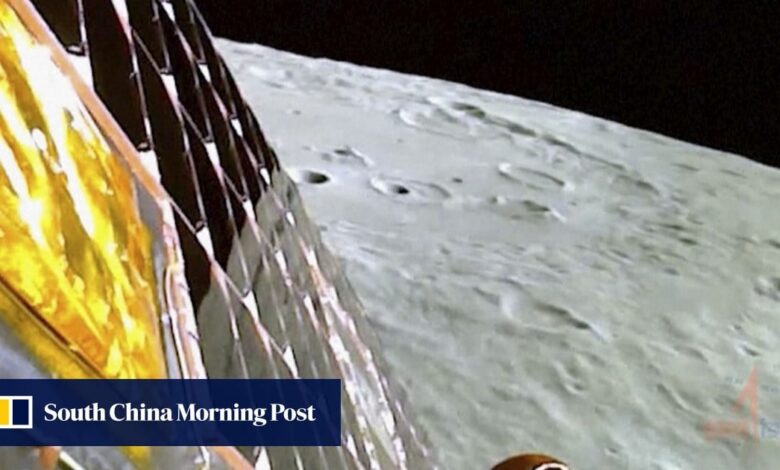Did India’s Chandrayaan-3 spacecraft really land near the moon’s south pole?

[ad_1]
Ouyang, a member of the Chinese Academy of Sciences, told its official Science Times newspaper that “the landing site of the Chandrayaan-3 was not at the moon’s south pole, not in the polar region of the moon’s south pole, nor was it ‘near the Antarctic polar region’”.
The rover landed at a latitude of around 69 degrees south. Ouyang told the news site it was within the moon’s southern hemisphere but not in the polar region, which he considered to be “between the latitudes of 88.5 and 90 degrees”.
The earth’s rotational axis is tilted at around 23.5 degrees relative to the sun, so the southern pole is defined to be between 66.5 and 90 degrees south. But Ouyang argued that since the moon’s tilt was only 1.5 degrees, the polar region was much smaller.
From the moon to the sun: India launches next space mission
From the moon to the sun: India launches next space mission
According to the European Space Agency, while the Chandrayaan-3 landing site was “strictly speaking not the south pole”, landing in the south pole proper was “incredibly difficult” due to its location on the rim of the Shackleton crater.
In the United States, Nasa has referred to the “entire” polar region as being from 80 to 90 degrees south. Under that definition, the Chandrayaan-3 landed outside the polar region but at a higher latitude than has been achieved by previous moon missions.
Nasa chief Bill Nelson posted a message on X, formerly known as Twitter, congratulating the Indian Space Research Organisation on their successful “lunar south pole landing” on August 23.
Richard de Grijs, a professor at Macquarie University’s School of Mathematical and Physical Sciences in Sydney, also said the Indian mission had landed in an area considered to be beyond the lunar south pole region.
“While the probe’s landing site is frequently referred to as the ‘polar region’ in news media and other publications, the location of Chandrayaan-3 is not within the lunar Antarctic Circle, defined as the lunar geographic region further south than 80 degrees south,” he said.
De Grijs pointed to a paper by scientists from the Physical Research Laboratory, a unit of the Indian government space department, published in the peer-reviewed journal Monthly Notices of the Royal Astronomical Society in early August.
In the paper, the team detailed their preparation work to determine a landing site, which they described as “a high-latitude location on the moon”.
Nasa chief warns moon’s south pole may become ‘another South China Sea’
Nasa chief warns moon’s south pole may become ‘another South China Sea’
In another study by researchers from the same unit, published on September 15 in solar system journal Icarus, they said the landing site was located in “the southern high-latitude region”.
“Many media may have jumped on the bandwagon by describing the landing site as a location near the lunar south pole,” de Grijs said, noting that “a few years ago some tentative evidence of the presence of water ice in frozen form was found near the moon’s south pole – much closer to the south pole than the location of Chandrayaan-3”.
He added that more studies were needed to determine if it was feasible to use the water ice for a possible future lunar base.
Planetary dynamicist Lee Man-hoi, from the University of Hong Kong, said the Chandrayaan-3 had reached the southernmost latitude of any lander on the moon. He also referred to the Indian team’s description of the site as a “high-latitude location”.
“You might think from the name that Chang’e 4 landed closer to the south pole, but that is not the case,” he said, adding that it had landed at a latitude of 45.44 degrees south.
Astrophysicist Quentin Parker, director of HKU’s Laboratory for Space Research, said the argument was getting into semantics, though the spacecraft had not strictly landed at the moon’s south pole.
“The moment you land a rover close to the south pole and certainly within what’s defined as the south pole region is already a major achievement,” he said. “I think that nothing should be taken away from India because of that.”
He said it was an opportunity to “celebrate the science and the achievements of humanity”.
“Anybody can go closer if they have the technical capacity to do so. India has gone closer than anyone else so far, but China can go closer next time and [it would be] great, fantastic if they do.”
China launches road map for exploring solar system’s resources
China launches road map for exploring solar system’s resources
Images from a presentation in April by China’s Deep Space Exploration Laboratory show a targeted landing site at 88.8 degrees south – within the boundaries of the polar region defined by Ouyang.
[ad_2]
Source link





